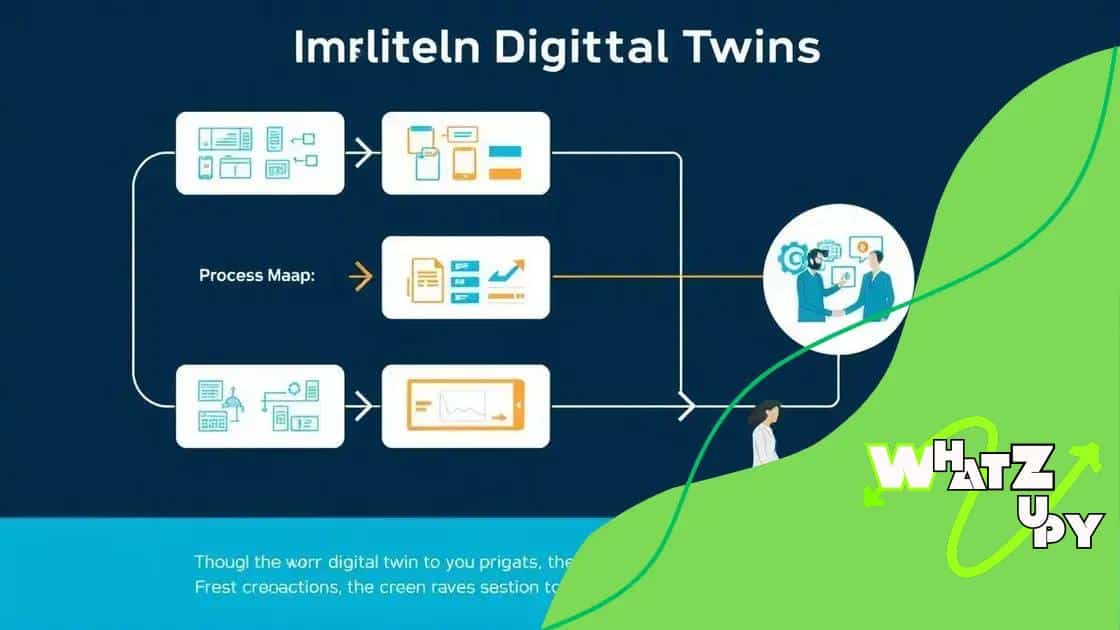Digital twins for optimizing business operations

Digital twins optimize business operations by providing real-time data and insights for improved decision-making, operational efficiency, and predictive maintenance across various industries.
Digital twins for optimizing business operations are changing how companies visualize and analyze their processes. Have you ever wondered how these digital replicas enhance performance? This article dives into this innovative technology.
Understanding digital twins and their significance
Digital twins are revolutionary tools that allow businesses to create a virtual representation of physical assets, processes, or systems. This technology enables companies to analyze and optimize their operations effectively. By utilizing digital twins, organizations can improve their decision-making and operational efficiency.
The Significance of Digital Twins
Understanding the significance of digital twins is crucial in today’s tech-driven landscape. They not only provide real-time data but also foster innovation and reduce costs. With these digital replicas, businesses can simulate various scenarios, helping them foresee outcomes without compromising real assets.
Key Features of Digital Twins
- Real-time monitoring of assets
- Data-driven insights for better decision-making
- Enhanced collaboration among teams
- Predictive maintenance to reduce downtime
Moreover, leveraging digital twins simplifies complex processes. They represent not just current states but also allow businesses to forecast future behaviors. This dual capability of understanding both the present and anticipating future trends makes digital twins indispensable for savvy organizations.
Applications in Various Industries
Various industries are quickly adopting digital twin technology. For instance, in manufacturing, digital twins can track equipment performance and optimize production lines. In healthcare, they can map patient journeys to enhance care and outcome. This adaptability across domains illustrates their broad relevance and utility in enhancing operations.
Investment in digital twin technology today can lead to significant benefits tomorrow. By better understanding their implications, organizations can harness their full potential. Leveraging digital twins will likely become a standard practice for companies aiming to remain competitive.
Key benefits of using digital twins
The key benefits of using digital twins are transforming the way companies operate. By simulating real-world scenarios, businesses can gain valuable insights into their processes and assets. This data-driven approach allows for informed decision-making and enhanced efficiency.
1. Improved Operational Efficiency
One major benefit is improved operational efficiency. Digital twins provide real-time data, enabling organizations to identify bottlenecks, monitor performance, and optimize workflows. This proactive management reduces downtime and enhances productivity.
2. Enhanced Predictive Maintenance
Another significant advantage is enhanced predictive maintenance. By analyzing data from digital twins, companies can predict when equipment is likely to fail, allowing them to perform maintenance before breakdowns occur. This can save time and reduce costs associated with unexpected repairs.
- Improve asset lifespan
- Reduce maintenance costs
- Minimize unplanned downtime
Unlike traditional maintenance strategies, using digital twins opens a pathway to a more reliable and efficient operation.
3. Better Product Development
Digital twins also aid in better product development. By testing designs and prototypes in a virtual environment, companies can gather feedback and make necessary adjustments before physical production. This not only speeds up the development process but also leads to higher quality products.
With digital twins, businesses can continuously refine their offerings. This adaptability becomes crucial for staying competitive in the fast-paced market.
4. Increased Collaboration and Innovation
Lastly, digital twins foster increased collaboration and innovation among teams. By having a shared platform for data and insights, departments can work together more effectively. This collaborative approach encourages innovative solutions that benefit the entire organization.
Utilizing digital twins can be a game-changing strategy for many industries. The advantages they offer support organizations in navigating challenges while improving overall performance.
How to implement digital twins in your business

Implementing digital twins in your business can seem daunting, but it can be a game-changer. Start with a clear understanding of your goals. This will help you determine what you aim to achieve by adopting this innovative technology.
1. Identify Key Processes
Begin by identifying the key processes you want to replicate digitally. Focus on areas where real-time data can significantly impact performance. For example, consider production lines, maintenance schedules, or supply chain management.
2. Select the Right Tools
Choosing the right tools for creating digital twins is critical. There are various software solutions available that can help with this task. Look for platforms that offer:
- Integration with existing systems
- User-friendly interfaces
- Robust data analysis capabilities
These features ensure that your implementation runs smoothly and efficiently.
3. Develop a Data Strategy
A strong data strategy is essential for building effective digital twins. Collect and manage data from sensors, equipment, and processes. Ensure that your data is accurate and up-to-date to improve the reliability of the digital twin.
Once you have the data, use it to create a virtual model. This model should reflect all aspects of the real-world asset or process.
4. Test and Validate
Before fully deploying your digital twin, conduct tests to validate its performance. Check how well it replicates real-world scenarios and fine-tune as needed. Testing ensures that any flaws are addressed before going live.
Finally, train your team on using the digital twin effectively. Make sure everyone understands how to interact with the model and analyze the insights it provides. This knowledge will maximize the benefits of implementing digital twins.
Real-world examples of digital twin applications
Real-world examples of digital twin applications highlight the versatility and effectiveness of this technology in various industries. Companies across sectors are leveraging digital twins to enhance their operations and achieve better outcomes. Here are some notable examples.
1. Manufacturing
In manufacturing, companies like Siemens utilize digital twins to optimize production processes. By creating a virtual model of the factory, Siemens can simulate production lines and identify inefficiencies. This approach reduces waste and improves overall productivity.
2. Healthcare
In the healthcare sector, digital twins are making waves. For instance, Philips has developed digital twins for individual patients. These models allow doctors to simulate treatment options and predict patient responses. This personalized approach improves patient care and leads to better health outcomes.
3. Smart Cities
Digital twins are also being implemented in urban planning. Cities like Dubai use digital twin technology to manage urban environments effectively. These models provide real-time data on traffic, air quality, and resource management. By analyzing this information, city planners can make informed decisions to enhance urban living.
- Improving traffic management
- Optimizing energy usage
- Enhancing public safety
The use of digital twins in smart cities is proving essential for sustainability and efficiency.
4. Aviation
In aviation, companies like Boeing employ digital twins to enhance aircraft maintenance. By creating models of airplane systems, they can monitor performance and predict failures before they happen. This proactive maintenance approach reduces downtime and increases safety.
With these real-world applications, it is clear that digital twins can drive innovation and efficiency across multiple industries. As technology continues to evolve, the potential for digital twins to reshape business operations becomes even greater.
Future trends in digital twin technology
The future trends in digital twin technology suggest exciting advancements that can further revolutionize industries. As more businesses adopt digital twins, several key trends are emerging that will shape the landscape.
1. Increasing Use of Artificial Intelligence
One significant trend is the increasing integration of artificial intelligence (AI) with digital twins. This combination allows for smarter analyses and predictive capabilities. AI can enhance the insights gained from digital twins, offering more accurate forecasts and recommendations. Businesses will be able to simulate several outcomes based on varying scenarios, optimizing their operations in real time.
2. Enhanced Data Analytics
As data continues to grow exponentially, advanced analytics will play a crucial role in the evolution of digital twin technology. Enhanced data analytics can lead to better understanding patterns and trends within the data. Organizations will leverage these insights to refine processes and improve efficiency.
3. Cloud and Edge Computing Integration
Another trend is the integration of cloud and edge computing with digital twins. This integration enables businesses to process vast amounts of data closer to the source, reducing latency and improving real-time decision-making. Cloud-based digital twins can be accessed by teams anywhere, fostering collaboration and innovation.
4. Expansion into New Industries
The application of digital twins is also expected to expand into new industries beyond traditional manufacturing and healthcare. Sectors like agriculture, retail, and energy are beginning to explore how digital twins can streamline operations and enhance product offerings. For example, in agriculture, digital twins can help optimize crop management by simulating growth conditions.
- Smart agriculture techniques
- Retail inventory optimization
- Sustainable energy management
These advancements indicate a growing recognition of the value digital twins can bring across various sectors.
As we look toward the future, it is clear that digital twin technology will continue to evolve, driving innovation and competitive advantage for businesses willing to embrace it. The possibilities are immense, offering a pathway to smarter, more efficient operations globally.
FAQ – Common Questions About Digital Twin Technology
What is a digital twin?
A digital twin is a virtual model of a physical asset, process, or system that allows businesses to analyze and optimize operations in real-time.
How can digital twins improve operational efficiency?
By providing real-time data and insights, digital twins help identify bottlenecks and optimize workflows, leading to improved productivity and reduced downtime.
Which industries are benefiting from digital twin technology?
Industries such as manufacturing, healthcare, aviation, and smart cities are leveraging digital twins to enhance their processes and decision-making.
What are future trends for digital twin technology?
Future trends include increased integration with AI, enhanced data analytics, and expansion into new industries like agriculture and retail, driving innovation and efficiency.





